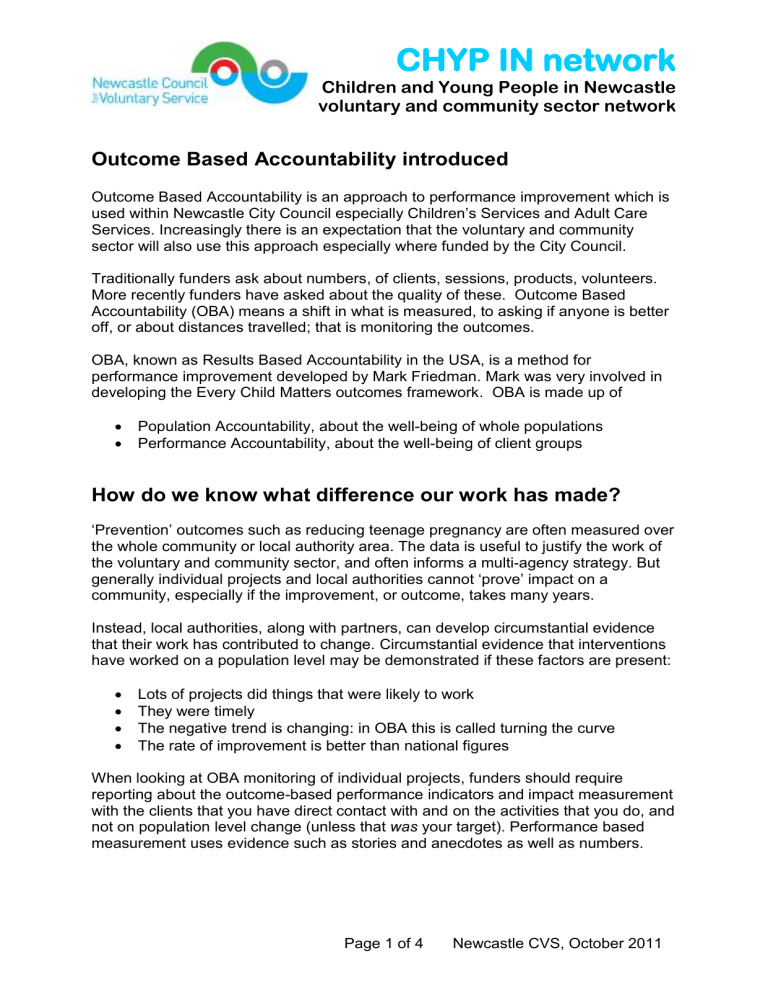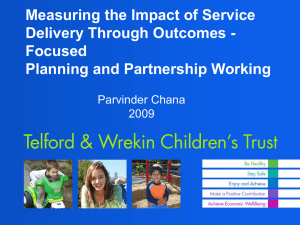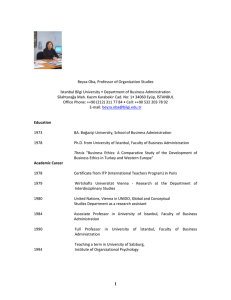Outcome Based Accountability introduced

CHYP IN network
Children and Young People in Newcastle voluntary and community sector network
Outcome Based Accountability introduced
Outcome Based Accountability is an approach to performance improvement which is used within Newcastle City Council especially Children’s Services and Adult Care
Services. Increasingly there is an expectation that the voluntary and community sector will also use this approach especially where funded by the City Council.
Traditionally funders ask about numbers, of clients, sessions, products, volunteers.
More recently funders have asked about the quality of these. Outcome Based
Accountability (OBA) means a shift in what is measured, to asking if anyone is better off, or about distances travelled; that is monitoring the outcomes.
OBA, known as Results Based Accountability in the USA, is a method for performance improvement developed by Mark Friedman. Mark was very involved in developing the Every Child Matters outcomes framework. OBA is made up of
Population Accountability, about the well-being of whole populations
Performance Accountability, about the well-being of client groups
How do we know what difference our work has made?
‘Prevention’ outcomes such as reducing teenage pregnancy are often measured over the whole community or local authority area. The data is useful to justify the work of the voluntary and community sector, and often informs a multi-agency strategy. But generally i ndividual projects and local authorities cannot ‘prove’ impact on a community, especially if the improvement, or outcome, takes many years.
Instead, local authorities, along with partners, can develop circumstantial evidence that their work has contributed to change. Circumstantial evidence that interventions have worked on a population level may be demonstrated if these factors are present:
Lots of projects did things that were likely to work
They were timely
The negative trend is changing: in OBA this is called turning the curve
The rate of improvement is better than national figures
When looking at OBA monitoring of individual projects, funders should require reporting about the outcome-based performance indicators and impact measurement with the clients that you have direct contact with and on the activities that you do, and not on population level change (unless that was your target). Performance based measurement uses evidence such as stories and anecdotes as well as numbers.
Page 1 of 4 Newcastle CVS, October 2011
Outcome Based Accountability introduced
Three tools to measure performance outcomes
1 Summary of performance measures
How much did we do?
Number & characteristic of clients
Number & type of activities
Least useful information in local
authorit y’s view
How well did we do?
% Common measures
Staff turnover, training, unit cost, customer satisfaction (Did we treat you well?)
% Activity specific measures percent of activities timely and correct, percent of clients completing activity, percent of actions meeting agreed standard
Is anyone better off?
Usually this information is in number and percentage, e.g. the number and percentage of people who stop taking drugs
Skills/knowledge
Attitude/opinion
% Skills/knowledge
% Attitude/opinion
Behaviour children ready for school problems?
% Behaviour young people remaining in supported tenancies
(Most useful to local authorities)
After identifying as many measures for your clients and work as possible, agree the most important 3 or 5 ‘Is anyone better off?’ measures to go in the lower right quarter
Put it onto a wall chart and track it each week/month/quarter.
Page 2 of 4 Newcastle CVS, updated October 2011
Outcome Based Accountability introduced
A practical example of performance measures:
Newcastle Connexions had a wall chart at Amber Court for its work on its NEET targets
How much did we do?
Staff teams – who, how many
What interventions
Stakeholders: parents, young people, groups etc
How well did we do?
% compliments, complaints and suggestions
Is anyone better off?
graph showing declining numbers of the % of young people who are not in education employment or training
chart showing numbers and percentage of 16 – 18 year olds participating in learning
NB this all assumes that you do have target outcomes
2 A suggestion for developing your user feedback and information about outcomes:
Ask 10% of your users 2 questions each month (amend the wording as appropriate for your project):
Did we treat you well?
Did we help you with your problems?
Page 3 of 4 Newcastle CVS, updated October 2011
Outcome Based Accountability introduced
3 The 7 Performance Accountability Questions
Set aside the first 15 minutes in staff supervision, or use staff meetings, team meetings, volunteer meetings or management committee meetings, for people in pairs to ask these 7 questions:
The 7 Performance Accountability Questions
1. Who are our customers?
2. How can we measure if our customers are better off?
3. How can we measure if we are delivering our services well?
4. How are we doing on the most important of these measures?
5. Who are the partners that have a role to play in doing better?
6. What works to do better, including no-cost and low cost ideas?
7. What do we propose to do?
To find out more
Visit www.resultsaccountability.com
and www.raguide.org
“Trying Hard is Not Good Enough” by Mark Friedman is a how to do it book available from www.trafford.com
Newcastle City Council is arranging OBA training for the sector in the near future
Page 4 of 4 Newcastle CVS, updated October 2011










